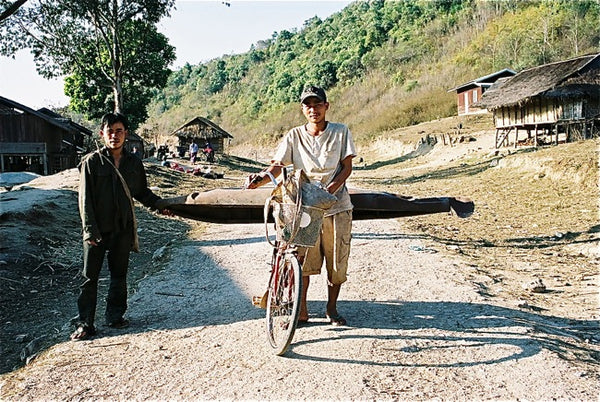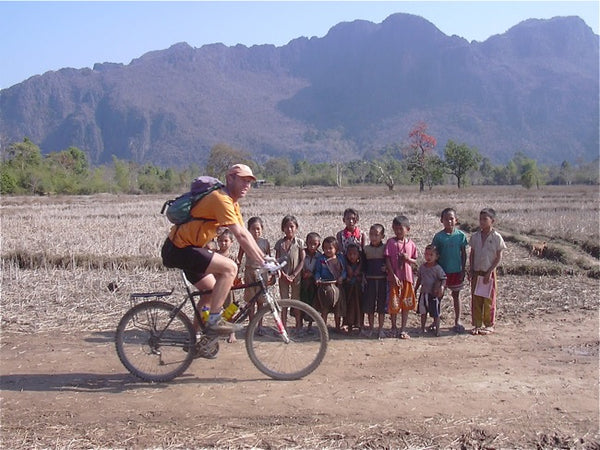Your Cart is Empty
Gear
FAQ
Blog
Laid-back Laos
01 August 2005
by Patrick Morgan
Picture yourself on an empty mountain road. Limestone peaks stretch all the way to the horizon. The sun is shining. There are villages every fifty kilometres, where you can refuel on tasty noodle soup for less than a dollar. As you cycle through villages, kids run out and cheer you like a Tour de France rider with a hearty "Sabaidee!"

Could Laos be the cruisiest cycling destination in Asia? With uncrowded roads, a low population and unspoiled scenery, it offers the adventurous cyclist heaps of opportunities to get off the beaten track. Laos is land-locked, wedged between Thailand and Vietnam. The same size as New Zealand, and with just 5 million inhabitants, it feels deserted compared to its bustling neighbours. Ten years of war and thirty years of communist government have left it one of the poorest places in Asia. Until recently, travel restrictions limited independent travellers' options. But with economic reforms and a recent relaxing of the red tape, now is the time to beat the crowds. Saddle up and head for Laos.

Cycling the Royal Road
To start my tour I chose the 437 km Royal Road from Vientiane to Luang Prabang. Last time I was in Laos, in 1992, Vientiane was surely the sleepiest capital in the world. Like Westport on a quiet Tuesday, but with dirt streets and more chickens. But the new Friendship Bridge across the Mekong River to Thailand has spurred a boom, and the whine of cheap motorbikes now buzzes around the whisky bars and internet cafes.

I headed north on Highway 10 to Ang Nam Ngum. This reservoir is speckled with islands, some of which were used as internment camps for political undesirables in the 1970s. A spooky hotel straight from a Stephen King novel lurks among the trees on one island. From the fishing village of Na Nam I chartered a boat with a couple of Italian beauties to the town of Ban Thahua. From there it was an easy ride to Vang Viang - the backpackers' centre of Laos. It lies on the scenic Nam Song River, surrounded by enchanting karst peaks and caves. Trekking to ethnic minority villages, tubing on the river and partying are the main attractions.

After a few days kicking back it was time to hit the road in search of hills. North of Vang Viang, Highway 13 climbs and descends 1000 metres past scattered villages, where the locals scratch out a living from slash and burn agriculture and hunting. Dogs sleeping on the road outnumber vehicles. Luang Prabang was my destination. Formerly home to the Lao royal family, the UN named it a World Heritage Site for its streets lined by temples and colonial French shop-houses. Although the French left fifty years ago, their influence remains. You can snack on pastries and coffee, and pick up baguettes and wine for a picnic. Early risers can see lines of monks emerging from fog-shrouded wats (monasteries) collecting their daily helping of rice. In the evening the main street is transformed into a lively night market, where you can bargain for fine handwoven silk or sample a spicy mango salad.

Up the Mekong
From Luang Prabang my route took me up the Mekong River towards the remote northeast province. With only a handful of highways in Laos, river travel takes over when the roads run out. Weathered wooden vessels haul freight and passengers at a leisurely pace into the heart of the jungle.Northeast Laos was home to the Vietnam-backed communist faction during the civil war. Rarely visited by tourists, you can tour a labyrinth of caves at Vieng Xai. Lao leaders made their home here for as long as ten years during the clandestine US bombing through the sixties and seventies. Caves were enlarged to include dormitories, meeting rooms, a hospital and even a concert hall.

Back on the road, I hitched a ride on a songtheuw - a pick-up truck with a couple of benches in the back. My bike was lashed to the side. Lao people have a cheerful can-do approach, which is necessary in a country impoverished by decades of war. Old bomb casings are reused as barbecue pits or fence posts. Aluminium from downed bombers is recycled as cutlery.
Travelling Underground
Further south, I explored the Khammouan National Biodiversity Conservation Area. Similar to National Parks, twenty NBCAs cover ten percent of Laos. They are earmarked for conservation and ecotourism in cooperation with the people who live there. The highlight was a 6 km boat ride through a cave used by the locals to travel between villages and fields. Six kilometres of darkness gives you plenty of time to ponder what could go wrong. Stepping into black water of unknown depth to help the boatmen wrestle the slender craft over a waterfall requires more faith than a bungy jumper. If you dropped your precious ring, I doubt if even Gollum could find it in the blackness.

Laos by bike is great. Highlights for me included the limestone scenery, intact Buddhist culture with monks and temples, relaxing river travel and zero traffic. On the downside, roads wash out in the rainy season, the infrastructure is primitive, andyou might not wantto leave.
Nitty Gritty
- When to go: December to February offers the best combination of warm temperatures and less rain. March to May is hot. The rainy season runs from May to November.
- To get to Laos, fly to Bangkok and take a sleeper berth on the overnight train to the border at Nong Khai. Choose the lower bunk fora cooler sleep. Cycle across the Mekong to Vientiane, the capital of Laos. Get your Lao visa while in Bangkok, through any guesthouse.
- Best map: Laos 2002 Guide Map. The 'Rough Guide to Laos' is the best guidebook. Lonely Planet's 'Cycling Vietnam, Laos & Cambodia' is also helpful.
- Take tools and spare parts. Locals ride cheap Chinese or Thai bikes, so quality spares are not available.
- A couple of links I found useful: Biking South East Asia and Cycling in Thailand and Laos.

UnderGround email List
Join our UnderGround newsletter for regular updates from our blog, new product releases and hot deals.
UnderGround email List
Join our UnderGround newsletter for regular updates from our blog, new product releases and hot deals.
